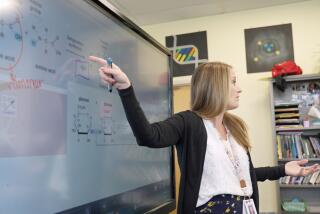Healthy Habit
- Share via
When Christina Geas took her 4-month-old daughter to a Westside clinic recently, she expected only routine vaccinations. But she left with a book and a prescription to read to her baby 15 minutes each day.
As Geas learned during her appointment at the pediatric clinic at Cedars-Sinai Medical Center, doctors, other staff and volunteers participate in Reach Out and Read. The program, at hospitals and clinics nationwide, calls for hospital personnel to encourage parents to explore books with their children.
At Cedars-Sinai, the waiting room at the pediatric clinic is stocked with books organized according to age. Geas found that little Tia Lane seemed to enjoy the story of “Clifford, the Big Red Dog,” by Norman Bridwell.
“At this age we encourage the parents to point to things, talk about the pictures. This is the process of getting the child used to a book,” said Dr. Neal Kaufman, who directs the free program at Cedars-Sinai. “In clinical experience, kids who are read to at an early age tend to be more verbal, use words better and have more direct communication with parents.”
Program administrators said their goal is to help prepare children for school so that they can succeed while there and ultimately land good jobs.
Each participating site has the flexibility to design its own program as long as it includes three required components: Physicians must speak with parents about the importance of reading, free books must be distributed and readers must be in the waiting room, said Abby Jewkes, national program administrator.
The program started in 1989 at Boston City Hospital (now Boston Medical Center) at a clinic serving low-income families. Pediatricians and volunteers are trained to promote reading during regular visits for children ages 6 months to 5 years.
Jewkes said the program now exists at 29 hospitals and clinics statewide and 351 nationwide. Funding includes grants by private foundations. Some sites have AmeriCorps volunteers.
Kaufman said the program at Cedars-Sinai, which started in May 1997, spends about $7,000 to $15,000 per year on books and about $15,000 to $20,000 for part-time help. The hospital’s cost depends on donations and in-kind services.
Most materials for the program are available only in English because only a small percentage of patients speak only Spanish, Kaufman said.
Another Reach Out and Read program was started in September at the Children’s Clinic in Long Beach, an independent clinic housed in Miller Children’s Hospital. The program has a specific list of books that it purchases at a discount from the publisher, plus donated books. Instructional materials and books are available in English and Spanish.
Dr. Elisa Nicholas, medical director of the Children’s Clinic, said the program attempts to address the problem of how low literacy ties into teenage pregnancy and risk-taking behaviors such as drug use.
“Reading to children shows that parents care about them. It’s what I call the ‘cuddle factor,’ ” Nicholas said. “Pediatricians should be prevention-oriented. We don’t just treat disease. We try to prevent death and disease.”
Kaufman said he often sees patients who may have been abused. One child he saw “was sweet and delightful until I tried to examine her private area. Her mother mentioned that she liked ‘101 Dalmatians.’ I read it to her and she relaxed. Her mother continued to read while I did the exam.”
Efforts to make doctor visits more comfortable for children include transforming traditional waiting rooms into fun-filled reading areas stocked with books and reading games.
*
At Cedars-Sinai, program coordinator Barbara Salinger-Brown wears a “story apron” with small stuffed animals attached with Velcro. Toddlers pull them off as she mentions each one in the story she tells.
“This way, the kids can participate in the story,” she said.
At the Children’s Clinic, children leave the rows of seats in the busy, crowded waiting room to listen as first-year residents and volunteers read to them.
“I see kids who come in here all sick and mopey-like,” said Robbie Emanuel, an AmeriCorps volunteer. “When you read to them, their faces light up.”
Several program participants said many parents, especially those who have limited English skills, can benefit from the program as well.
Dr. Shakha Vora recalled giving books to two sisters, 11 and 3. “The older one looked at the younger one’s book and said, ‘This’ll be great for Mom so she can learn how to read.’ ”
Araceli Medina, who brought her two preschool children to the clinic in Long Beach in early January, said that she started reading to her children after she started coming to the clinic. She said she does not read much in English but is learning by looking at the pictures in the children’s books.
“I read to my children every day,” Medina said in Spanish. “They’re talking to me more. They’re learning more.”
More to Read
Sign up for Essential California
The most important California stories and recommendations in your inbox every morning.
You may occasionally receive promotional content from the Los Angeles Times.













